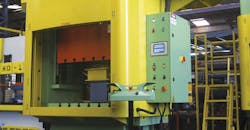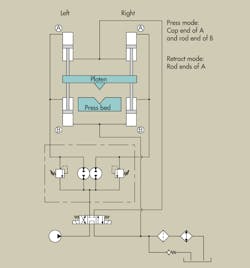Troubleshooting Challenge: Press Platen Racking on Assembly Machine
A manufacturer of large castings used in earth graders wanted to be able to press large bushings into different locations on the casting. It did not want to have to reposition each casting to access different positions using a C-type press, so it had a gantry-style, movable press built that would roll on rails to access all the holes needing bushings.
The bottom of the gantry had legs with wheels running on top of heavy-duty H-beam rails mounted to the floor. Wheels underneath the top flange of the H beam kept the gantry frame from lifting when pressing.
The schematic provided by the company, reproduced here, shows that the pressing cycle routes hydraulic oil to the cap end of the top cylinders while also sending oil to the rod end of the bottom cylinders. Oil was routed to just the rod ends of the top cylinders to raise the platen because high force was not needed for the return cycle.
However, a problem developed when the top platen was lowered to press on the bushing. The right side would extend faster than the left side for a short distance, and then the left side would take off faster than the right side and cause the platen to tilt in the opposite direction. Technicians switched the outputs of the flow divider to see if the problem was reversed, but it had no effect on what was taking place. They did notice, though, that tank line pressure upstream of the return filter spiked 300 to 350 psi at the beginning of the retract cycle, even though a separate 65-psi check valve bypassed the filter and heat exchanger.
Any idea what was happening?
Find the Solution
Think you know the answer to this month’s problem? Submit your solution via e-mail. All correct answers submitted by October 30, 2018 will be entered into a random drawing for a $50 gift card. The winner will be notified, and his or her name will be printed in a future issue. Only one gift card will be awarded to any participant within a calendar year.
Solution to Last Month’s Challenge:
Coiled-Steel Unwinder Oscillates
Pressure oscillations in load-sensing circuits can be caused by control orifices, such as the 0.042-in. orifice shown on the circuit. The Vickers/Eaton CT-06 relief valve with remote control calls for the remote-control orifice diameter to be 0.040 in. or larger. However, you don’t want it too large, or it will generate heat. Excessive heat is not only evidence of inefficiency but can also degrade the hydraulic fluid. The problem with it being smaller than 0.040 in. is that it can generate noise and oscillations, which was the case here.
The mechanic said he could see daylight through the orifice with a flashlight. However, once he removed the orifice, he found a partial obstruction. Cleaning out the orifice solved the problem.
About the Author
Robert Sheaf
President
Robert J. Sheaf Jr., is the founder and president of CFC Industrial Training, formerly Certified Fluid Consultants, part of CFC-Solar Inc. CFC-Solar provides technical training, consulting, and field services to any industry using fluid power technology.

Leaders relevant to this article:


